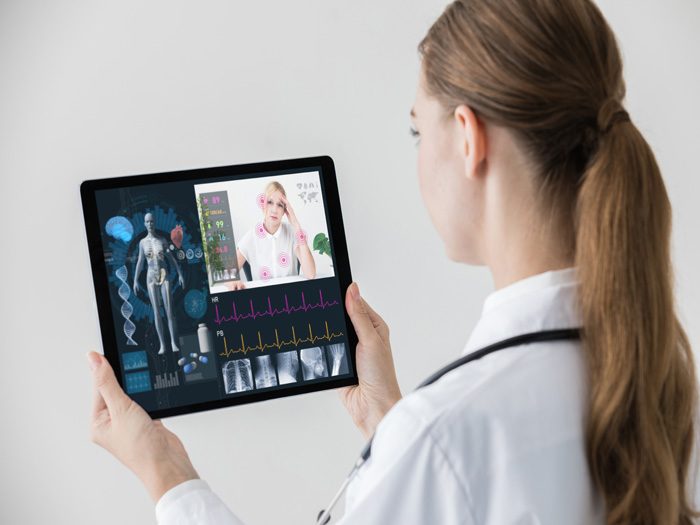COVID-19 and Injured Workers: Telehealth Provides Digital Access to Recovery

As COVID-19 rages on, businesses are seeing all sorts of closures. Twenty-eight states currently have statewide or partial shelter-in-place orders and 23 states have closed all non-essential businesses.
These closures are drawing attention as to which businesses are considered essential, with many facilities that serve injured workers, including physical therapy centers, shutting their doors in the name of public health.
Without these services, injured workers may not be able to move forward with their recovery.
Given that delayed recovery is considered one of the industry’s biggest challenges by workers’ comp professionals, the inability for injured workers to receive care for an undetermined amount of time should be deeply concerning to anyone managing injured worker claims and care.
“There’s no question that care will be interrupted across the board,” said Mary O’Donoghue, chief operating officer at MedRisk.

Mary O’Donoghue, chief operating officer, MedRisk
“Continuity of care is very important, and that’s one of the things that we try very hard to make sure that we are focused on.”
In the wake of business closures, telemedicine is stepping up to provide care for injured workers. Since COVID-19 began and stay at home orders started rolling in, companies providing telehealth services have seen a massive shift to digital care.
“We have seen a 250% increase in March, the number of video conferencing we’ve done with patients compared to January and February of this year,” said Erin Zablocki, executive director of rehab technology for ATF Medical.
This massive shift has occurred because many workers’ compensation programs see it as the only way to insure continuity of care during the virus.
“It’s the only option in a lot of cases,” said Michelle Despres, vice president and national product leader, physical therapy, at OneCall.
“We want to make sure that they have access to the care they need. We want to make sure they have the ability to work with people that are exceptionally trained. It’s all about getting the person well, getting the person to be more functional, and allowing them to get back to their normal life and normal work.”
Telemedicine Steps in to Keep Recovery on Track
To keep injured worker care on track, telemedicine programs have stepped in to help injured workers with everything from continued physical therapy appointments to making sure their medical devices are working properly.
Some programs are finding that they’re able to adapt existing telemedicine services to serve as a vehicle for continuation of care during COVID-19.
At MedRisk, their telerehab program, which has been running for almost three years, combines in-person visits with video conference visits that an employee can access if they’re travelling, for example.
In the time of coronavirus, it provides injured workers with an opportunity to continue their care even as brick and mortar clinics temporarily close their doors.
“We want to make sure that they have access to the care they need … It’s all about getting the person well, getting the person to be more functional, and allowing them to get back to their normal life and normal work.” – Michelle Despres, vice president and national product leader, physical therapy, OneCall
“Through the telerehab process, our goal is to improve function and independence through guided exercises,” O’Donoghue said.
“After the visit, we upload all of their exercises, instructions, videos into the patient portal. So at any point after the visit, if they can’t remember specifically how certain exercises are supposed to be performed, they can just get into their patient portal and all that information is available to them.”
Other telehealth physical therapy platforms, such as those being used at OneCall, focus on trying to recreate the feel of in-patient visits and on using methods, such as the McKenzie Method of Mechanical Diagnosis and Therapy, which are “conducive to being virtual.”
“It’s one-on-one, the encounter with the PT. Everything that’s being done is done the same way that they do it in the clinic, only they’re doing it virtually through a smart phone, tablet, or video enabled computer,” Despres said. “When we look at our virtual physical therapists, because they have that additional certification in mechanical diagnosis and treatment, that training is known to really generate tremendous outcomes.”
In addition to allow physical therapy appointments to occur during COVID-19, telehealth platforms can also help injured workers using medical equipment receive the care they need.

Erin Zablocki, executive director of rehab technology, ATF Medical
“We utilize the Zoom platform to teleconference with the patient so that we can see what’s happening with their equipment,” Zablocki said.
“We can hear the sounds, the noises. We can get a good visual of it, so we can make a game plan before we even go there. Oftentimes, we don’t even have to make a trip out then. We can just make a final trip to whatever repairs are necessary.”
This is particularly important because if an injured worker isn’t using medical equipment correctly it can cause other injuries and further delay care.
“If they have something wrong with a wheelchair that’s not working right for them or they have something that’s not fitting them or they’re not able to position themselves properly, that can cause skin breakdown, which takes months and years to heal,” Zablocki said.
Care from the Comfort of Home
Telemedicine is also a good solution for injured workers or other employees who may skip going to see a doctor entirely for fear of being contaminated by the virus.
“Telerehab offers the ability to continue treating or to start care through a virtual encounter. So, anyone who needs outpatient physical therapy but is fearful of going out in public or attending a clinic, they can do this from the comfort of their homes,” Despres said.
“One of my biggest concerns is that people will avoid getting treated or accessing care, because they didn’t want to be exposed,” Misty Guinn, director of benefits and wellness at Benefitfocus, added.
“That’s one of the big things that I’ve been telling employers and our employees, the telehealth aspect is not just for COVID-19 related situations. Please use that for any and all care issues.”
Telehealth Is Being Used for Other Benefits As Well
In addition to providing support for workers’ compensation patients, telehealth programs are stepping in to fill voids in other employee benefits areas.
The federal government announced that it would immediately expand telemedicine access to people with Medicare and other health care providers have followed.
“Most health insurance carriers swiftly crossed the shelf and kind of stepped up and actually waived any cost sharing for telemedicine,” Guinn said.
“It’s important for us at this time to really promote it, but then encourage it, reduce any of those barriers, whether it’s technology, incentivizing people to use it, even for non-COVID medical issues, just because we’re trying to avoid exposure and transmission.”
Employee mental health programs are also moving towards telemedicine as the COVID-19 outbreak continues.
Due to shelter-in-place orders which deprive employees of needed social contact and the fears surrounding the virus, experts are noting that there may be a spike in the number of people experiencing mental illness.
Mental illness and stress among employees can interfere with their personal and professional lives daily.
“This pandemic is definitely leaving its mark on our society. The workforce will definitely remember how employers responded to protect their employee’s health and wellbeing.” – Misty Guinn, director of benefits and wellness, Benefitfocus
One in 25 adults lives with mental illness severe enough to interfere with major life activities and mental health claims increased 10% year over year between 2015 and 2018, according to a 2019 study. The virus could make these numbers even higher.
As a result, some employers are offering telemedicine services, including apps, that help their employees focus on their mental well being.
“Even if they didn’t have pre-existing mental health conditions, many people are having symptoms,” Guinn said.
“This pandemic is definitely leaving its mark on our society. The workforce will definitely remember how employers responded to protect their employee’s health and wellbeing.”
Move to Telemedicine May Continue After COVID-19 Ends
Even after COVID-19 ends, workers’ comp programs may continue to rely on telemedicine for more treatments, including physical therapy.
The programs are frequently as effective as in-patient physical therapy visits and they can offer injured workers more flexibility for when they receive treatments.
Some providers note that a combined in-person and telehealth physical therapy approach results in a quicker recovery for injured workers.
“We find that on average, about three less PT visits take place per episode when you go with the hybrid model,” O’Donoghue said.
On the medical equipment side, telemedicine services also speed up equipment repairs.
“Even outside of the pandemic, we were able to address issues faster, get the repairs done quicker, order parts quicker, sometimes even order product quicker,” Zablocki said.
All in all, coronavirus may be just speeding up a transition to telemedicine that was already occurring within workers’ comp.
“I hope what comes out of this is heightened awareness and recognition of the value telemedicine overall can play as a part of our healthcare system in general,” O’Donoghue said. “I just think that could be one of the silver linings that comes out of this crisis.” &








